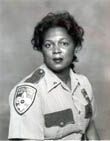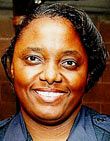 Chief Dion R. Nelson Sr. |
Dion R. Nelson Sr. was a dedicated public servant with a fierce sense of duty to his community and his country. As Director of Public Safety for York, Alabama, he was not only police chief, but also fire chief. For 16 years, he was in the Army Reserves and served in Iraq during Operation Iraqi Freedom.
On September 24, 2005, his public service came to a tragic end. During a period of heavy rain associated with the aftermath of Hurricane Rita, Chief Nelson was involved in a fatal car crash while responding to another automobile accident. His car hydroplaned on the wet roadway and struck the rails of a bridge and another vehicle.
“He was always coming up with new ways to improve the departments he directed and he was the kind of leader that provided solutions and not criticism,” York Mayor Carolyn Gosa said of her 34-year-old police chief. “The personnel adored and respected him. He new how to treat people with dignity and fairness,” she added.
This past May, Chief Nelson had his name added to the walls of the National Law Enforcement Officers Memorial in Washington, D.C. He was one of 21 African American law enforcement officers to be killed in the line of duty last year, and among nearly 600 who have made the ultimate sacrifice throughout our nation’'''s history.
According to the records kept by the National Law Enforcement Officers Memorial Fund (NLEOMF), the first known African American officer to die in the line of duty was William Johnson of the Jacksonville (FL) Sheriff’'''s Office. On April 10, 1870, he was picked up and slammed to the ground by a drunken man after responding to a disturbance call. He died two days later of the injuries he suffered.
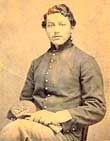 Officer William L. Copeland |
Among the 13 other African American officers who were killed on duty during the 1800s were Portsmouth (VA) Patrolman John Wilson, who was shot to death during a civil disturbance that broke out at a political event on November 11, 1871; and William L. Copeland, a Little Rock (AR) police officer who was stabbed and beaten to death in December 1885 by a state prison convict who was allowed out at times to perform odd jobs.
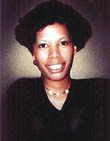 Officer Gail Cobb |
Washington, D.C. Metropolitan Police Officer Gail Cobb was just 24 years old when she was gunned down in 1974 while trying to arrest a bank robber she had tracked down in a downtown garage. She is the only female officer in the history of her department to die in the line of duty and the nation’'''s first African-American policewoman to make the ultimate sacrifice. Her death came 55 years after Georgia Robinson of the Los Angeles Police Department became the first African American policewoman to serve in 1919.
|
The chaplain officiating at her funeral of Gail Cobb told the packed church, “Her death established the fact that the criminal makes no distinction between the sexes.” In fact, today there are 210 female officers honored on the National Law Enforcement Officers Memorial and 37 are African Americans. Among the others are Baton Rouge (LA) Police Officer Betty Dunn Smothers, who was shot and killed in 1993, and is the mother of NFL star running back, Warrick Dunn; and Kay Rogers, a Murfreesboro (TN) police officer who in 2005 became the first and only female officer ever to be killed in a motorcycle crash.
More African American officers died in the line of duty in 2001 (33) than in any other year. Of course, that included 9-11, the deadliest incident in law enforcement history. Seventy-two officers died that day and 13 of them were African Americans. Among them was William “Harry” Thompson, a popular and highly respected 27-year veteran of the New York State Office of Court Administration. He was at the training academy on Williams Street, just a short distance away from the World Trade Center when the attacks occurred. Captain Thompson, along with several other instructors and officers who were at the academy that day, ran to the scene. He stayed in the South Tower until the very end, moving people to safety and aiding the injured.
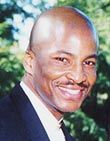 Captain William ''''Harry’''' Thompson |
Another infamous case a few years earlier had also drawn the national spotlight. Jacob J. Chestnut, an 18-year police veteran, was manning a security station at the U.S. Capitol when a crazed gunman named Russell Weston Jr. entered. Weston’'''s father said his son was delusional and “would argue with a fence post.” But even Weston had enough sense to know that the man with the badge on his chest and a gun at his side was an obstacle to his madness. So he pointed his pistol at the back of Officer Chestnut’'''s head and pulled the trigger. Moments later, Weston would also shoot and kill U.S. Capitol Police Detective John Gibson. Officer Chestnut is one of 13 African Americans killed in federal law enforcement service.
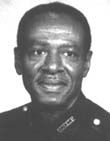 Officer Jacob J. Chestnut |
D’'Antonio Washington, a correctional officer with the Federal Bureau of Prisons, was viciously assaulted in December 1994 by an inmate who beat him to death with a hammer. The ambush occurred at the U.S. Penitentiary in Atlanta, Georgia. He is one of 28 African American correctional officers with their names on the National Law Enforcement Officers Memorial.
James I. Alexander’'''s book, “Blue Coats; Black Skin,” examines the experience of African American police officers in New York City. He found photographic evidence that African American officers were working in New York City as early as 1865. But it was not until August 6, 1917, that the first New York City African American officer was killed in the line of duty. His name was Robert H. Holmes, who was shot and killed after surprising a burglar escaping from an apartment window. Twenty thousand people lined the streets of New York to honor Patrolman Holmes during his funeral, which marked the first time in City history that flags were ordered flown at half-staff for a fallen police officer.
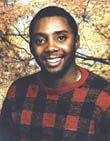 Officer D’'Antonio Washington |
Throughout history, 28 New York City African American police officers have been killed in the line of duty, more than any other department. Among them was Dillon Stewart, 35, who was killed in 2005. Officer Dillon was shot while attempting to pull over a car with stolen license plates that had sped through a red light. Miraculously, Officer Stewart did not even realize he had been wounded and pursued the suspect in his unmarked patrol vehicle. A short while later Officer Stewart was rushed to the hospital, where he died.
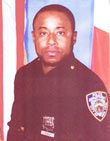 Detective Dillon Stewart |
Nearly 90 years had passed, but the sendoff for Dillon Stewart was no different than for Robert Holmes — some 20,000 police officers and many others lined the route to the burial site and flags throughout the City were lowered to half-staff in honor of a fallen hero.


